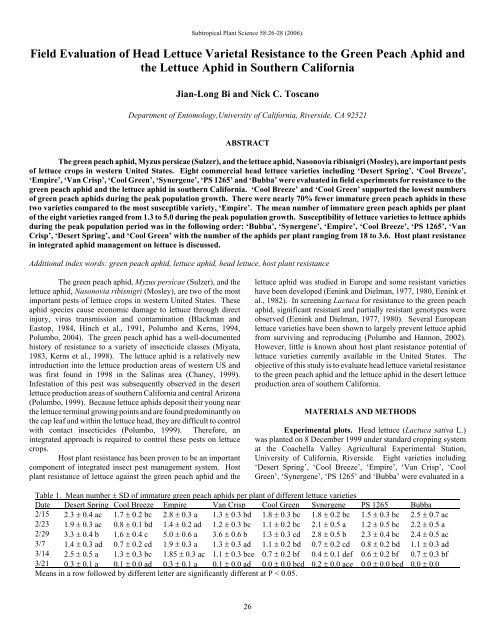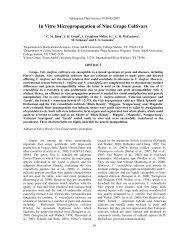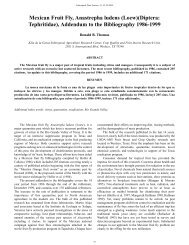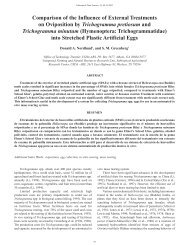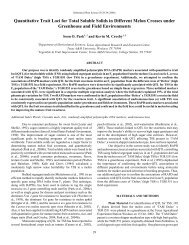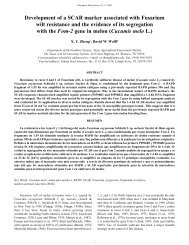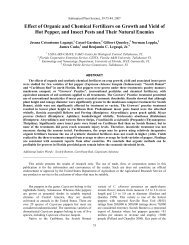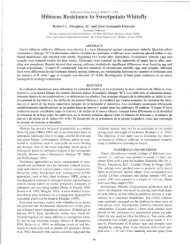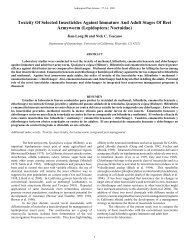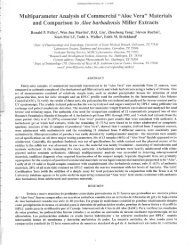Host Plant Resistance against Aphids - Subtropical Plant Science ...
Host Plant Resistance against Aphids - Subtropical Plant Science ...
Host Plant Resistance against Aphids - Subtropical Plant Science ...
Create successful ePaper yourself
Turn your PDF publications into a flip-book with our unique Google optimized e-Paper software.
<strong>Subtropical</strong> <strong>Plant</strong> <strong>Science</strong> 58:26-28 (2006).<br />
Field Evaluation of Head Lettuce Varietal <strong>Resistance</strong> to the Green Peach Aphid and<br />
the Lettuce Aphid in Southern California<br />
Jian-Long Bi and Nick C. Toscano<br />
Department of Entomology,University of California, Riverside, CA 92521<br />
ABSTRACT<br />
The green peach aphid, Myzus persicae (Sulzer), and the lettuce aphid, Nasonovia ribisnigri (Mosley), are important pests<br />
of lettuce crops in western United States. Eight commercial head lettuce varieties including ‘Desert Spring’, ‘Cool Breeze’,<br />
‘Empire’, ‘Van Crisp’, ‘Cool Green’, ‘Synergene’, ‘PS 1265’ and ‘Bubba’ were evaluated in field experiments for resistance to the<br />
green peach aphid and the lettuce aphid in southern California. ‘Cool Breeze’ and ‘Cool Green’ supported the lowest numbers<br />
of green peach aphids during the peak population growth. There were nearly 70% fewer immature green peach aphids in these<br />
two varieties compared to the most susceptible variety, ‘Empire’. The mean number of immature green peach aphids per plant<br />
of the eight varieties ranged from 1.3 to 5.0 during the peak population growth. Susceptibility of lettuce varieties to lettuce aphids<br />
during the peak population period was in the following order: ‘Bubba’, ‘Synergene’, ‘Empire’, ‘Cool Breeze’, ‘PS 1265’, ‘Van<br />
Crisp’, ‘Desert Spring’, and ‘Cool Green’ with the number of the aphids per plant ranging from 18 to 3.6. <strong>Host</strong> plant resistance<br />
in integrated aphid management on lettuce is discussed.<br />
Additional index words: green peach aphid, lettuce aphid, head lettuce, host plant resistance<br />
The green peach aphid, Myzus persicae (Sulzer), and the<br />
lettuce aphid, Nasonovia ribisnigri (Mosley), are two of the most<br />
important pests of lettuce crops in western United States. These<br />
aphid species cause economic damage to lettuce through direct<br />
injury, virus transmission and contamination (Blackman and<br />
Eastop, 1984, Hinch et al., 1991, Polumbo and Kerns, 1994,<br />
Polumbo, 2004). The green peach aphid has a well-documented<br />
history of resistance to a variety of insecticide classes (Miyata,<br />
1983, Kerns et al., 1998). The lettuce aphid is a relatively new<br />
introduction into the lettuce production areas of western US and<br />
was first found in 1998 in the Salinas area (Chaney, 1999).<br />
Infestation of this pest was subsequently observed in the desert<br />
lettuce production areas of southern California and central Arizona<br />
(Polumbo, 1999). Because lettuce aphids deposit their young near<br />
the lettuce terminal growing points and are found predominantly on<br />
the cap leaf and within the lettuce head, they are difficult to control<br />
with contact insecticides (Polumbo, 1999). Therefore, an<br />
integrated approach is required to control these pests on lettuce<br />
crops.<br />
<strong>Host</strong> plant resistance has been proven to be an important<br />
component of integrated insect pest management system. <strong>Host</strong><br />
plant resistance of lettuce <strong>against</strong> the green peach aphid and the<br />
lettuce aphid was studied in Europe and some resistant varieties<br />
have been developed (Eenink and Dielman, 1977, 1980, Eenink et<br />
al., 1982). In screening Lactuca for resistance to the green peach<br />
aphid, significant resistant and partially resistant genotypes were<br />
observed (Eenink and Dielman, 1977, 1980). Several European<br />
lettuce varieties have been shown to largely prevent lettuce aphid<br />
from surviving and reproducing (Polumbo and Hannon, 2002).<br />
However, little is known about host plant resistance potential of<br />
lettuce varieties currently available in the United States. The<br />
objective of this study is to evaluate head lettuce varietal resistance<br />
to the green peach aphid and the lettuce aphid in the desert lettuce<br />
production area of southern California.<br />
MATERIALS AND METHODS<br />
Experimental plots. Head lettuce (Lactuca sativa L.)<br />
was planted on 8 December 1999 under standard cropping system<br />
at the Coachella Valley Agricultural Experimental Station,<br />
University of California, Riverside. Eight varieties including<br />
‘Desert Spring’, ‘Cool Breeze’, ‘Empire’, ‘Van Crisp’, ‘Cool<br />
Green’, ‘Synergene’, ‘PS 1265’ and ‘Bubba’ were evaluated in a<br />
Table 1. Mean number ± SD of immature green peach aphids per plant of different lettuce varieties<br />
Date Desert Spring Cool Breeze Empire Van Crisp Cool Green Synergene PS 1265 Bubba<br />
2/15 2.3 ± 0.4 ac 1.7 ± 0.2 bc 2.8 ± 0.3 a 1.3 ± 0.3 bd 1.8 ± 0.3 bc 1.8 ± 0.2 bc 1.5 ± 0.3 bc 2.5 ± 0.7 ac<br />
2/23 1.9 ± 0.3 ac 0.8 ± 0.1 bd 1.4 ± 0.2 ad 1.2 ± 0.3 bc 1.1 ± 0.2 bc 2.1 ± 0.5 a 1.2 ± 0.5 bc 2.2 ± 0.5 a<br />
2/29 3.3 ± 0.4 b 1.6 ± 0.4 c 5.0 ± 0.6 a 3.6 ± 0.6 b 1.3 ± 0.3 cd 2.8 ± 0.5 b 2.3 ± 0.4 bc 2.4 ± 0.5 ac<br />
3/7 1.4 ± 0.3 ad 0.7 ± 0.2 cd 1.9 ± 0.3 a 1.3 ± 0.3 ad 1.1 ± 0.2 bd 0.7 ± 0.2 cd 0.8 ± 0.2 bd 1.1 ± 0.3 ad<br />
3/14 2.5 ± 0.5 a 1.3 ± 0.3 bc 1.85 ± 0.3 ac 1.1 ± 0.3 bce 0.7 ± 0.2 bf 0.4 ± 0.1 def 0.6 ± 0.2 bf 0.7 ± 0.3 bf<br />
3/21 0.3 ± 0.1 a 0.1 ± 0.0 ad 0.3 ± 0.1 a 0.1 ± 0.0 ad 0.0 ± 0.0 bcd 0.2 ± 0.0 ace 0.0 ± 0.0 bcd 0.0 ± 0.0<br />
Means in a row followed by different letter are significantly different at P < 0.05.<br />
26
<strong>Subtropical</strong> <strong>Plant</strong> <strong>Science</strong> 58:26-28 (2006).<br />
Table 2. Mean number ± SD of immature lettuce aphids per plant of different lettuce varieties<br />
Date Desert Spring Cool Breeze Empire Van Crisp Cool Green Synergene PS 1265 Bubba<br />
2/15 1.1 ± 0.6 b 1.3 ± 0.7 b 0.2 ± 0.1 b 0.0 ± 0.0 b 0.7 ± 0.5 b 0.9 ± 0.6 b 0.5 ± 0.2 b 3.2 ± 1.3 a<br />
2/23 2.2 ± 0.8 c 3.2 ± 0.9 b 1.0 ± 0.4 c 3.2 ± 1.9 b 1.9 ± 0.6 c 10.4 ± 2.2 a 5.2 ± 0.9 b 6.0 ± 1.6 b<br />
2/29 5.4 ± 1.1 f 10.8 ± 1.4 b 13.9 ± 2.5 bcd 7.3 ± 1.7 f 3.6 ± 0.7 f 15.7 ± 2.4 ac 8.5 ± 1.5 e 17.6 ± 2.7 ad<br />
3/7 8.7 ± 1.1 bc 10.9 ± 1.4 ac 7.6 ± 1.5 bc 5.6 ± 0.9 b 6.6 ± 1.2 b 14.4 ± 1.5 a 9.9 ± 1.7 bc 14.6 ± 1.9 a<br />
3/14 6.5 ± 0.9 bc 5.3 ± 0.8 b 9.8 ± 1.3 a 4.7 ± 0.8 be 3.0 ± 0.3 de 4.1 ± 0.7 be 1.7 ± 0.3 d 8.0 ± 1.1 ac<br />
3/21 0.8 ± 0.2 a 1.0 ± 0.3 a 0.9 ± 0.3 a 0.8 ± 0.3 ac 0.8 ± 0.3 ad 0.1 ± 0.0 bcd 0.6 ± 0.3 ad 0.7 ± 0.3 ad<br />
Means in a row followed by different letter are significantly different at P < 0.05.<br />
randomized complete block design with four replicates. The plot<br />
size was 15 m long and 8 m wide. Row spacing was 0.9 m and<br />
there were 8 rows in each plot. <strong>Plant</strong>s were thinned at the 5-leaf<br />
stage to 20 cm interval spacing. The field was drip-irrigated. The<br />
frequency of irrigation was every 3 days.<br />
Aphid numbers. Numbers of immature green peach<br />
aphids and lettuce aphids were monitored from 15 February to 21<br />
March 2000 on a weekly basis. Numbers of aphids were counted<br />
on each of the 10 randomly selected lettuce plants (by destructive<br />
sampling) in the middle four rows of each plot.<br />
Data analysis. The least significant difference (LSD) test<br />
in one-way randomized complete block ANOVA in SAS (SAS<br />
Institute, 2001) was used to analyze the data and to separate the<br />
means for each sampling date. Numbers of immature aphids were<br />
transformed using the formula log (y + 1) before analysis of<br />
variance in order to normalize the data.<br />
RESULTS AND DISCUSSION<br />
The seasonal aphid population peaked in late February and<br />
declined in mid-March (Tables 1 and 2). Among the 8 varieties<br />
tested, ‘Cool Breeze’ and ‘Cool Green’ supported the least number<br />
of green peach aphids during the peak population period (around 29<br />
February). They had nearly 70% fewer immature green peach<br />
aphids than the most susceptible variety, ‘Empire’. The mean<br />
number of immature green peach aphids per plant of the eight<br />
varieties ranged from 1.3 to 5.0 during the peak population period<br />
(Table 1). On 29 February, susceptibility of the lettuce varieties to<br />
lettuce aphids was in the following order: ‘Bubba’, ‘Synergene’,<br />
‘Empire’, ‘Cool Breeze’, ‘PS 1265’, ‘Van Crisp’, ‘Desert Spring’<br />
and ‘Cool Green’ (least susceptible) with the number of aphids per<br />
plant ranging from 18 to 3.6 (Table 2).<br />
Polumbo and Hannon (2002) investigated the population<br />
growth of lettuce aphids on resistant butter and head lettuce<br />
varieties in central Arizona and found that plants of several<br />
varieties almost completely prevented aphid colonization.<br />
Although we did not find complete prevention of aphid<br />
colonization in this study, the differences in numbers of the aphids<br />
among varieties were significant.<br />
Results of this study suggest that some varieties such as<br />
‘Cool Green’ and ‘Cool Breeze’ are more resistant to green peach<br />
aphids, while ‘Cool Green’ and ‘Van Crisp’ are more resistant to<br />
lettuce aphids. <strong>Plant</strong> resistance to aphids has been largely<br />
attributed to the plant physiology and biochemistry (Van Emden et<br />
al., 1969, Niemeyer, 1990). A pea variety resistant to the pea aphid<br />
(Aphis fabae Scopodi) had a higher sugar/nitrogen ratio and lower<br />
amounts of soluble nitrogen (Maltais and Auclair, 1957, Auclear<br />
and Maltais, 1961). The rates of ingestion and assimilation by the<br />
pea aphid were also higher in susceptible than in resistant varieties<br />
(Auclair, 1959). The resistance of some tobacco varieties to the<br />
green peach aphid was due to a toxic material in the leaves<br />
(Thurston and Webster, 1962). Phenolic compounds such as<br />
chlorogenic acid, gallic acid and catechol in artificial diet caused<br />
enhanced mortality and reduced development of the green peach<br />
aphid and the lettuce aphid (Harrewijn, 1990). Benzyl alcohol was<br />
claimed to be involved in greenbug (Schizaphis graminum<br />
Rondani) resistance of Barley (Juneja et al., 1972, 1975). The<br />
exact physiological and biological mechanisms of the green peach<br />
aphid and the lettuce aphid resistance in head lettuce in this study<br />
need to be further investigated.<br />
Partial resistance of some head lettuce varieties to the<br />
green peach aphid and the lettuce aphid was observed in this study.<br />
The use of such partially aphid-resistant varieties in combination<br />
with biological control agents (e.g. predators, parasites and<br />
bioinsecticides) could be the most environmentally friendly and<br />
economic method of aphid control in lettuce production.<br />
Furthermore, the results of this study suggest that lettuce breeding<br />
and selection for increased aphid resistance may be a viable option.<br />
Higher levels of aphid resistance could be developed from these<br />
partially resistant varieties by traditional plant breeding and/or<br />
genetic engineering.<br />
ACKNOWLEDGEMENTS<br />
We thank Greg R. Ballmer for his assistance in the field<br />
work. This research was partly supported by California Iceberg<br />
Lettuce Advisory Board.<br />
LITERATURE CITED<br />
Auclair, J. L. 1959. Feeding and excretion by the pea aphid,<br />
Acyrthosiphon pisum (Harr.), reared on different varieties of<br />
peas. Entomol. Exp. Appl. 2:279-286.<br />
Auclair, J. L., and J. B. Maltais. 1961. The nitrogen economy of<br />
the pea aphid, Acyrthosiphon pisum (Harris), on susceptible<br />
and resistant varieties of pea, Pisum sativum L. Proc. Intern.<br />
Congr. Entomol., 12th, Vienna, 1:740-743.<br />
Blackman, R. L., and V. F. Eastop. 1984. <strong>Aphids</strong> on the World’s<br />
Crops: An Identification Guide. John Willy & Sons, New<br />
York. 406pp.<br />
Chaney, B. 1999. Lettuce aphid update. In Monterey County<br />
Cooperative Extension, Salinas, CA. April, 199:1-7.<br />
27
<strong>Subtropical</strong> <strong>Plant</strong> <strong>Science</strong> 58:26-28 (2006).<br />
Eenink, A. H., and F. L. Dielman. 1977. Screening Lactuca for<br />
resistance to Myzus persicae. Neth. J. Path. 83:139-151.<br />
Eenink, A. H., and F. L. Dielman. 1980. Development of Myzus<br />
persicae on a partially resistant and on a susceptible genotype<br />
of lettuce (Lactuca sativa) in relation to plant age. Neth. J.<br />
Path. 86:111-116.<br />
Eenink, a. H., R. Groenword, and F. L. Dielman. 1982. <strong>Resistance</strong><br />
of lettuce (Lactuca) to the leaf aphid Nasonovia ribisnigri. I.<br />
Transfer of resistance from L. virosa to L. sativa by<br />
interspecific crosses and selections of resistant breeding lines.<br />
Euphytica 31:291-300.<br />
Harrewijn, P. 1990. <strong>Resistance</strong> mechanisms of plant genotypes to<br />
various aphids, pp. 117-130. In P. K. Campbell and R. D.<br />
Eikenbary (eds). Aphid-plant Genotype Interactions. Elsevier,<br />
Amsterdam, Oxford, New York, Tokyo.<br />
Hinch, R. T., P. V. Veil, J. S. Tebbets, and D. F. Hoffman. 1991.<br />
Live insects and other arthropods on California iceberg head<br />
and shredded lettuce. Southwest Entomol. 16:261-266.<br />
Juneja, P. S., R. K. Gholson, R. L. Burton, and K. J. Starks. 1972.<br />
Chemical basis for greenbug resistance in small grains. I.<br />
Bbenzyl alcohol as a possible resistance factor. Ann. Entomol.<br />
Soc. Am. 65:961-964.<br />
Juneja, P. S., S. C. Pearcy, and P. K. Gholson. 1975. Chemical<br />
basis for greenbug resistance in small grains. II. Identification<br />
of the major neutral metabolites of benzyl alcohol in barley.<br />
<strong>Plant</strong> Physiol. 56:385-389.<br />
Kerns, D. L., J. C. Polumbo, and D. N. Byrne. 1998. Relative<br />
susceptibility of red and green forms of green peach aphid to<br />
insecticides. 1998 Vegetable Report, University of Arizona,<br />
C o l l e g e o f A g r i c u l t u r e .<br />
http://ag.arizona.edu/pubs/crops/az1101_25.html.<br />
Maitais, J. B., and J. L. Auclair. 1957. Factors in resistance of<br />
peas to the pea aphid, Acryrthosiphon pisum (Harr.). I. The<br />
sugar-nitrogen ratio. Can. Entomol. 89:365-370.<br />
Miyata, T. 1983. Detection and monitoring for resistance in<br />
arthropods based on biochemical characteristics, pp. 99-116.<br />
In G. Georgiou and T. Saito (eds) Pest <strong>Resistance</strong> to<br />
Pesticides. Plenum Press, New York.<br />
Niemeyer, H. M. 1990. Secondary plant chemicals in aphid-host<br />
interactions, pp. 101-114. In D. C. Peters, J. A. Webster and<br />
C. S. Chlouber (eds) Proc. Aphid-plant Interactions:<br />
Populations to Molecules, Stillwater, Oklahoma, USA.<br />
Polumbo, J. C. 1999. Preliminary examination of the population<br />
dynamics and control of the lettuce aphid in Romaine, pp. 130-<br />
135. 1999 Vegetable Report, University of Arizona, College<br />
of Agriculture, Series, P-117, AZ1143.<br />
Polumbo, J. C. 2004. Is aphid management sustainable in desert<br />
head lettuce? 2004 Vegetable Report, University of Arizona,<br />
College of Agriculture and Life <strong>Science</strong>s.<br />
http://ag.arizona.edu/pubs/crops/az12481.<br />
Polumbo, J. C., and D. L. Kerns. 1994. Effect of imidacloprid as<br />
a soil treatment on colonization of green peach aphid and<br />
marketability of lettuce. Southwest Entomol. 19:339-346.<br />
Polumbo, J. C., and T. A. Hannon. 2002. Population growth of<br />
lettuce aphid, Nasonovia ribisnigris, on resistant butter and<br />
head lettuce. 2002 Vegetable Report, University of Arizona,<br />
College of Agriculture and Life <strong>Science</strong>s.<br />
http://ag.arizona.edu/pubs/crops/az124892.<br />
SAS Institute. 2001. SAS/STAT user’s guide, release 8.2 ed. SAS<br />
Institute, Cary, North Carolina.<br />
Thurston, R. and J. A. Webster. 1962. Toxicity of Nicotiana<br />
gossei Domin to Myzus persicae (Sulzer). Entomol. Exp.<br />
Appl. 5:233-238.<br />
Van Emden, H. F., V. P. Eastop, R. D. Hughus, and M. J. Way.<br />
1969. The ecology of Myzus persicae. Ann. Rev. Entomol.<br />
14:197-269.<br />
28


